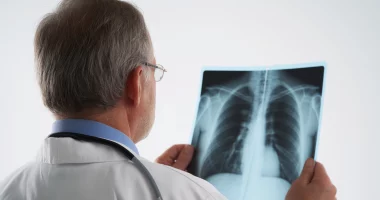Craniopharyngioma
Definition
Craniopharyngioma is a benign cystic-epithelial neoplasm localized in the region of the Turkish saddle, which develops from the remnants of the epithelium of Rathke’s cleft. With the progression and growth of the tumor, the patient has an increase in intracranial pressure, visual impairment, lag in physical and mental development, and hypofunction of the adenohypophysis. The most informative methods of diagnosing craniopharyngioma are MRI and CT, which help to determine the structure, boundaries of the tumor, and the presence of calcinates. Treatment is surgical, after which the patient is prescribed a course of radiation therapy aimed at stopping further growth of the neoplasm.
General information
Craniopharyngioma is a brain tumor of benign character, which originates from the embryonic period and is usually located in the hypothalamic-pituitary region. As the neoplasm progresses, cysts may form in its tissues, which are filled with fluid with a high content of cholesterol and proteins. The disease is more common in children but can occur at any age.
The incidence of craniopharyngiomas is approximately 2-3% of all brain neoplasms. Neuroepithelial craniopharyngioma is the most common (about 10% of cases), with the peak development occurring between the ages of 5 and 15. Another type of craniopharyngioma, papillary craniopharyngioma, occurs most often in people after 40 years of age.
Causes of craniopharyngioma development
The main causes of craniopharyngioma are heredity and various mutations. In addition, the development of pathology is influenced by unfavorable factors, especially in the first trimester of pregnancy. Causative factors of craniopharyngioma include the influence of drugs, toxins, poisons, radiation, etc.; intrauterine infection, severe early toxicosis; and chronic diseases of the pregnant woman (tuberculosis, diabetes mellitus, renal failure).
Craniopharyngioma is divided into two types: adamantinomatous and papillary. About 60% of craniopharyngiomas are cystic, about 15% are solid masses, and the remaining 35% have a mixed structure and pattern.
Craniopharyngioma develops from embryonic remnants of Rathke’s cleft, a structure from which the adenohypophysis later forms and develops. The neoplasm usually has cysts and calcificates in adults. Due to its localization and progression, craniopharyngioma causes developmental delay in children, visual function disorders, and endocrine system diseases in adults.
Symptoms of craniopharyngioma
Craniopharyngiomas may not manifest clinically for an extended period. Most often, the first symptoms of the disease occur closer to 5-10 years of age. The primary manifestations that force the patient to consult a doctor are constant headaches that are not controlled by analgesics, neurological disorders, and disorders in the endocrine system.
As the tumor progresses, it begins to compress the hypothalamus, pituitary gland, and optic junction, which makes the clinical symptomatology more pronounced and vivid. The most typical clinical manifestations of craniopharyngioma are obesity and short stature.
Progression and growth of the tumor cause deterioration of the patient’s vision at the initial stage, to which doctors pay attention during the initial examination of the patient. At later stages of the disease development, an ophthalmologist’s examination with ophthalmoscopy reveals irreversible changes on the ocular fundus, edema, and optic nerve atrophy. The severity of the clinical picture largely depends on the size and degree of progression of the neoplasm.
The main sign of craniopharyngioma, which can only be determined by cranial radiologic examination, is a change in the Turkish saddle. The thinning of its back and cuneiform processes can be clearly seen in the image.
Diagnosis of craniopharyngioma
The diagnosis of craniopharyngioma consists of instrumental modern diagnostics and consultation with a neurologist. An X-ray of the skull allows you to identify calcinates in the tumor, erosion of its walls, and an increase in the size of the Turkish saddle. The patient must conduct several tests to determine the level of hormones in the blood.
MRI and CT of the brain are the most informative and accurate methods of diagnosing craniopharyngioma. With the help of these research methods, the specialist obtains a layer-by-layer image of brain tissues, which allows one to determine the most accurate location of the pathological process, the size of the formation, the structure and shape of the tumor, and its location relative to the surrounding tissues.
Craniopharyngioma should be differentiated from other tumors of the pituitary region: pituitary adenoma, chiasmaticglioma, germinoma, and colloid cyst of the III ventricle. Accurate differentiation of tumors is possible only after histological examination of their tissues.
Craniopharyngioma treatment
Craniopharyngioma is treated surgically and is performed by neurosurgeons. The way of access to the tumor depends mainly on its location and size. If complete removal of the neoplasm for some reason is impossible, then in the postoperative period, radiation therapy methods are used.
Resection of craniopharyngioma eliminates the tumor’s pressure on the pituitary gland and neighboring brain tissues, and radiation therapy can stop the tumor’s progressive growth in 90% of cases. A modern and effective method of craniopharyngioma treatment is drainage of the cyst and injection of an antibiotic into its cavity, which destroys tumor tissues and cells.
All these treatment options are available in more than 650 hospitals worldwide (https://doctor.global/results/diseases/craniopharyngioma). For example, Brain tumors surgery can be performed in 30 clinics across Turkey for an approximate price of $11.4 K (https://doctor.global/results/asia/turkey/all-cities/all-specializations/procedures/brain-tumors-surgery).
Prognosis and prevention
In most cases, the prognosis depends on the timeliness of diagnosis and the experience of doctors during surgical intervention. Recurrence of the disease occurs in the first three years after surgery and occurs, as a rule, with non-radical removal of the neoplasm. One of the complications in the postoperative period is the development of non-sugar type diabetes, so the patient needs long-term hormone replacement therapy under the supervision of an endocrinologist.
In addition, although the use of radiation therapy is an effective way to stop further growth and progression of the tumor, it causes mental retardation in children and severe damage to internal organs, particularly the liver. Prevention of the pathologic process consists of antenatal protection of the fetus.



